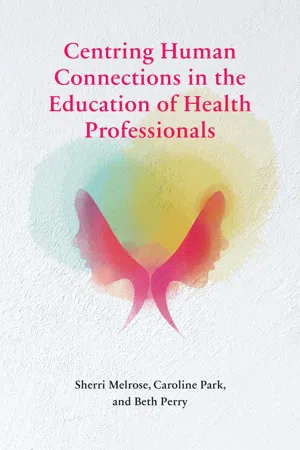![]()
1
Celebrating Human Connections in Teaching
A human connection is the energy that exists between people when they feel seen, heard, and valued; when they can give and receive without judgment; and when they derive sustenance and strength from the relationship.
—Brené Brown (2010, p. 5)
The environments in which health professionals gain knowledge, skills, and attitudes that they need in their practice can be dominated by technology and mechanized procedure-oriented approaches. Health professionals achieve the competencies required by their discipline in clinical, classroom, and online settings. Health professional learners include pre-service students enrolled in higher education programs and in-service practitioners participating in graduate studies or continuing education activities. Students and practitioners in all health disciplines are expected to become, and remain, self-directed lifelong learners. Whether learners are registered in formal health profession programs or simply seek information on current best practices, they must reach out and engage with informed others and relevant resources as part of their learning.
Human connections can support learners in achieving success in all learning environments. Yet, in many instances, learners remark that they feel alone, disconnected from other students and the teacher, and bereft of human contact. Learning in isolation can negatively influence the educational experience. Learning outcomes that focus on higher-order affective domain competencies such as responding to phenomena and internalizing values are often best facilitated through human interaction and interpersonal communication.
For learners in the health professions in particular, learning in a community is essential. Health professionals provide care, kindness, and compassion to people when they are at their most vulnerable. Processes that students experience in their pre- and in-service education should model, integrate, and celebrate these human connections. Educators need to actively pursue ways to humanize the curriculum for health-care providers. In an early explanation of how educators can humanize education, Dutton (1976, p. 79) offered this simple explanation: “Make students feel ten feet tall.”
In this chapter, we begin with a glimpse of what the concept of human connection means. Next, we provide a brief introduction to humanizing pedagogy with a discussion of how educational environments that embrace immediacy, praxis, and affective learning can help educators and learners to establish successful human connections. We emphasize how personalizing learning, by inviting learners to set individual goals and by offering opportunities for “voice and choice,” can play a critical role in the education of health professionals. In each section, we include practical (and proven) strategies that serve one of two purposes. Some boxed strategies are designed for educators to assist them in reflecting on whether they approach learners in humanizing ways. Other boxed strategies are approaches that educators can use to help learners (in a variety of educational settings) “feel ten feet tall.”
THE CONCEPT OF HUMAN CONNECTION
People engage and connect with one another in different ways and for different reasons throughout their lives. Psychologist Mathew Lieberman (2014) suggested that the human brain is wired to connect with others and that this need to connect with others is even greater than the need for food or shelter. In some instances, when connections with others extend beyond superficial conversations or interactions to include profound and meaningful communications, those involved can feel a deep sense of shared humanity.
Understanding the concept of human connection is not straightforward. The role that humanity can play in interactions is not easy to define. Most of us would associate the meaning of the word humanity with the simple definition of “a quality or state of being human” (Merriam-Webster, n.d.). But the definition of humanity also explains that the concept includes “compassionate, sympathetic or generous behaviour or disposition: the quality or state of being humane” (Merriam-Webster, n.d.). This definition is particularly important for educators who teach learners in the health professions. The definition suggests that people’s behaviour toward others (e.g., educators’ behaviour toward learners) is what makes them human or at least humane humans.
Deconstructing the definition further leads to a cursory examination of the requisite humanizing behaviour of compassion. Compassion means a “sympathetic consciousness of others’ distress together with a desire to alleviate it” (Merriam-Webster, n.d.). It is beyond the scope of this book to fully explain behaviours that demonstrate compassion. However, it is important to emphasize the vital role that compassionate behaviour can play in cultivating relationships rich in humanity. Fostering human connections in health professionals’ education begins when educators strive to act with compassion, to recognize distress in their students, and perhaps most notably to alleviate or reduce that distress.
In contrast, behaviours that are inhumane and lacking in compassion are not difficult to identify. Behaviours that could be described as callous, insensitive, and unfeeling are clearly inhumane. In their literature review of humane interpersonal relationships among Russian educators, Kleptsova and Balabanov (2016) noted that educators considered inhumane are likely to be more oriented to themselves, to identify others with their own ideas of good and bad, and to behave immaturely. As well, inhumane educators were described as demonstrating egoism, anger, envy, fear, cynicism, apathy, aggression, indifference, detachment, and idleness. Although educators might not intentionally act in inhumane ways, it is important to recognize that inhumane behaviours can be present and that they do not support positive, compassionate, and humane connections among educators and learners. The following strategy can initiate individual reflection and awareness building related to the importance of human connection in teaching.
